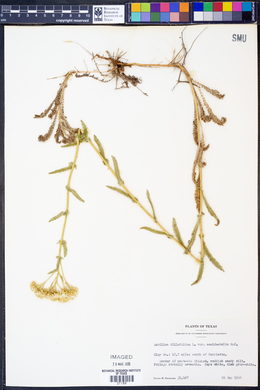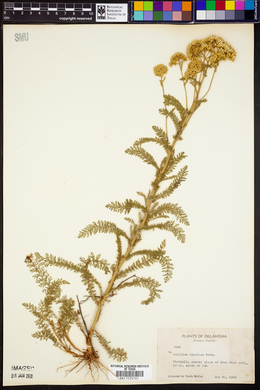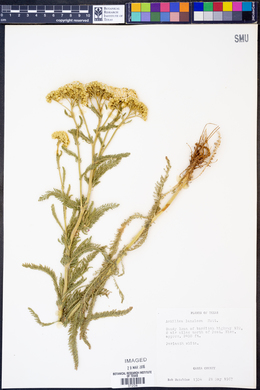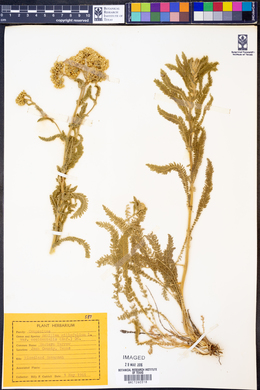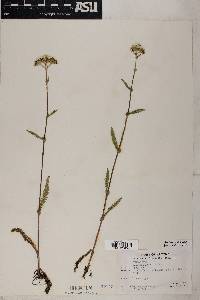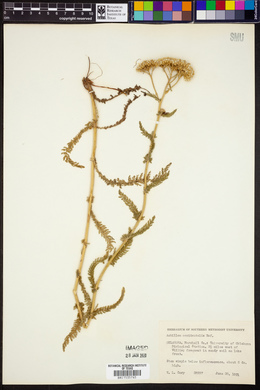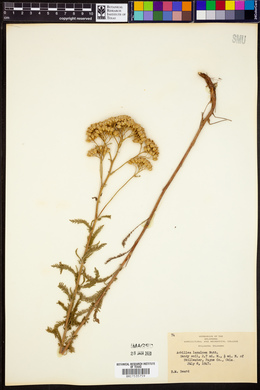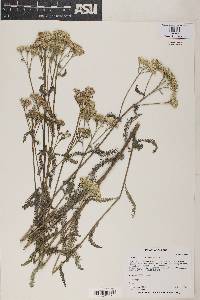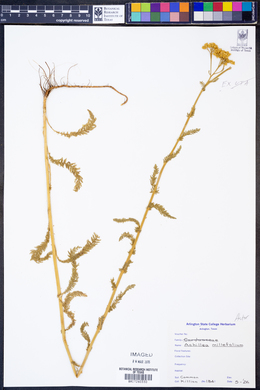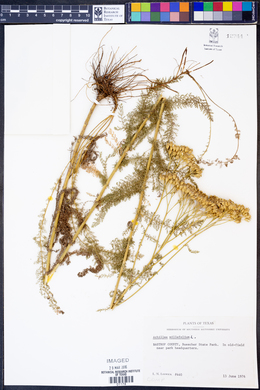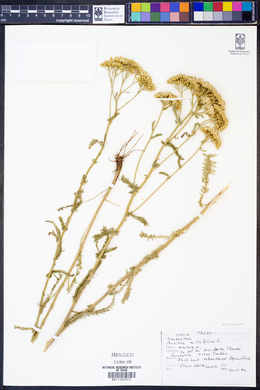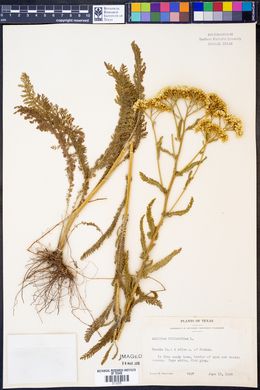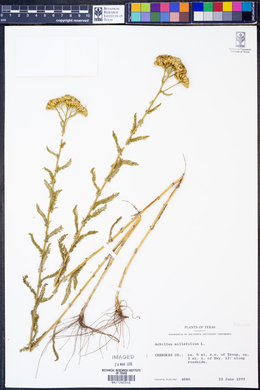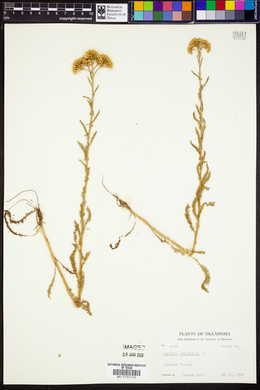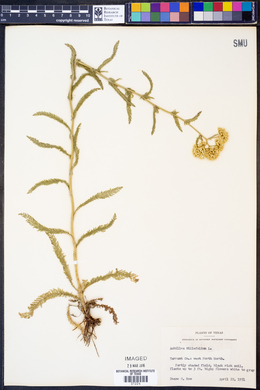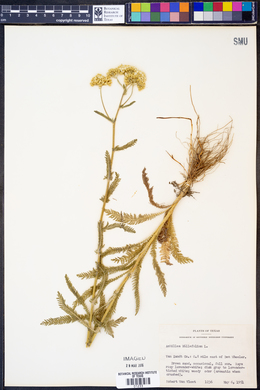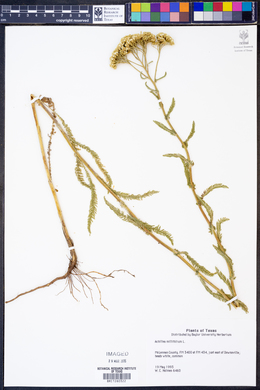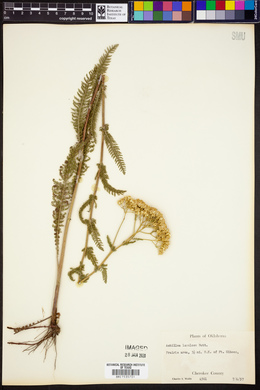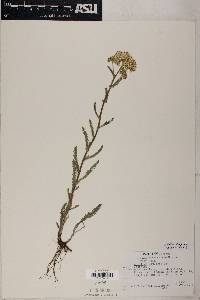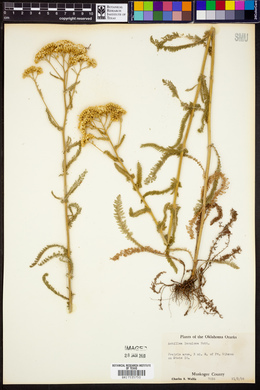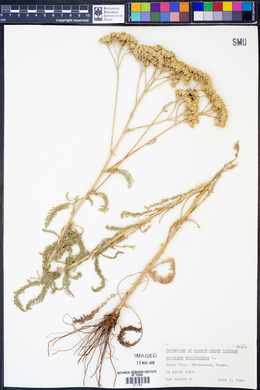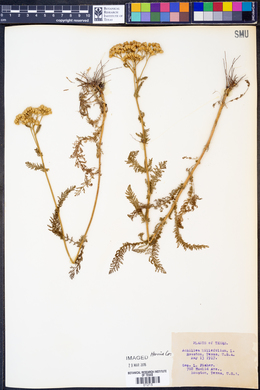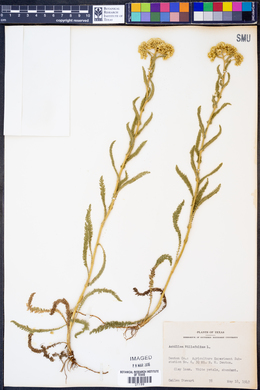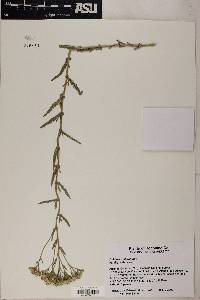|
|
|
|
Family: Asteraceae
common yarrow, more...common yarrow, western yarrow, bloodwort, carpenter's weed, hierba de las cortaduras, milfoil, plumajillo, western yarrow, yarrow (common) (es: canfor)
[Achillea alpicola (Rydb.) Rydb., moreAchillea angustissima Rydb., Achillea arenicola A. Heller, Achillea aspleniifolia auct. non Vent., Achillea borealis Bong., Achillea borealis ssp. arenicola (A. Heller) D.D. Keck, Achillea borealis ssp. californica (Pollard) D.D. Keck, Achillea borealis ssp. typica D.D.Keck, Achillea borealis var. arenicola (A. Heller) J.T. Howell, Achillea borealis var. californica (Pollard) J.T. Howell, Achillea californica Pollard, Achillea eradiata Piper, Achillea fusca Rydb., Achillea gigantea Pollard, Achillea gracilis Raf., Achillea lanulosa Nutt., Achillea lanulosa ssp. alpicola (Rydb.) Keck, Achillea lanulosa ssp. typica Keck, Achillea lanulosa var. alpicola Rydb., Achillea lanulosa var. arachnoidea Lunell, Achillea lanulosa var. eradiata (Piper) M.E. Peck, Achillea laxiflora Pollard & Cockerell, Achillea millefolium ssp. atrotegula B.Boivin, Achillea millefolium ssp. borealis (Bong.) Breitung, Achillea millefolium ssp. lanulosa (Nutt.) Piper, Achillea millefolium ssp. occidentalis (DC.) Hyl., Achillea millefolium ssp. pallidotegula Boivin, Achillea millefolium var. alpicola (Rydb.) Garrett, Achillea millefolium var. arenicola (A. Heller) Nobs, Achillea millefolium var. aspleniifolia (Vent.) Farw., Achillea millefolium var. borealis Farw., Achillea millefolium var. californica (Pollard) Jeps., Achillea millefolium var. fulva B.Boivin, Achillea millefolium var. fusca (Rydb.) G.N. Jones, Achillea millefolium var. gigantea (Pollard) Nobs, Achillea millefolium var. gracilis Raf. ex DC., Achillea millefolium var. lanulosa (Nutt.) Piper, Achillea millefolium var. litoralis Ehrend. ex Nobs, Achillea millefolium var. maritima Jeps., Achillea millefolium var. megacephala (Raup) B. Boivin, Achillea millefolium var. nigrescens E. Mey., Achillea millefolium var. occidentalis DC., Achillea millefolium var. pacifica (Rydb.) G.N. Jones, Achillea millefolium var. parviligula B.Boivin, Achillea millefolium var. parvula B.Boivin, Achillea millefolium var. puberula (Rydb.) Nobs, Achillea millefolium var. rosea (Desf.) Torr. & Gray, Achillea millefolium var. russeolata Boivin, Achillea nigrescens (E. Mey.) Rydb., Achillea occidentalis (DC.) Raf. ex Rydb., Achillea pacifica Rydb., Achillea puberula Rydb., Achillea rosea Desf., Achillea subalpina Greene, Achillea tomentosa Pursh, non L.] |
Perennials, 6-65+ cm (usually rhizomatous, sometimes stoloniferous). Stems 1(-4), erect, simple or branched, densely lanate-tomentose to glabrate. Leaves petiolate (proximally) or sessile (distally, weakly clasping and gradually reduced); blades oblong or lanceolate, 3.5-35+ cm × 5-35 mm, 1-2-pinnately lobed (ultimate lobes ± lanceolate, often arrayed in multiple planes), faces glabrate to sparsely tomentose or densely lanate. Heads 10-100+, in simple or compound, corymbiform arrays. Phyllaries 20-30 in ± 3 series, (light green, midribs dark green to yellowish, margins green to light or dark brown) ovate to lanceolate, abaxial faces tomentose. Receptacles convex; paleae lanceolate, 1.5-4 mm. Ray florets (3-)5-8, pistillate, fertile; corollas white or light pink to deep purple, laminae 1.5-3 × 1.5-3 mm. Disc florets 10-20; corollas white to grayish white, 2-4.5 mm. Cypselae 1-2 mm (margins broadly winged). 2n = 18, 27, 36, 45, 54, 63, 72 (including counts from Europe). Flowering late Apr-early Jul (south), mid Jul-mid Sep (north). Pastures, meadows, roadsides, stream sides, woodlands, waste grounds, dry or sandy soils, also in damp, clayey, and salty soils; 0-3600 m; Greenland; St. Pierre and Miquelon; Alta., B.C., Man., N.B., Nfld. and Labr., N.W.T., N.S., Nunavut, Ont., P.E.I., Que., Sask., Yukon; Ala., Alaska, Ariz., Ark., Calif., Colo., Conn., Del., D.C., Fla., Ga., Idaho, Ill., Ind., Iowa, Kans., Ky., La., Maine, Md., Mass., Mich., Minn., Miss., Mo., Mont., Nebr., Nev., N.H., N.J., N.Mex., N.Y., N.C., N.Dak., Ohio, Okla., Oreg., Pa., R.I., S.C., S.Dak., Tenn., Tex., Utah, Vt., Va., Wash., W.Va., Wis., Wyo.; Mexico; Eurasia. Achillea millefolium is morphologically variable and has been treated as either a single species with varieties or as multiple distinct species. At least 58 names have been used for North American specimens. Some early workers (e.g., J. Clausen et al. 1948) thought the native North American plants were taxonomically distinguishable from introduced, Old World plants. Other workers (e.g., R. J. Tyrl 1975) have treated A. millefolium as a cosmopolitan, Northern Hemisphere polyploid complex of native and introduced plants that have hybridized, forming diploid, tetraploid, pentaploid, hexaploid, septaploid, and octoploid plants and/or populations constituting a single, variable species. Morphologic characters that have been used to segregate these populations into species and/or varieties include: (1) degree and persistence of tomentum; (2) phyllaries with greenish, light brown, or dark brown margins; (3) shapes of capitulescences (rounded or flat-topped); and (4) degrees of leaf dissection and shapes of lobes. While examining specimens for this treatment, two general trends were noted: (1) Plants growing either at high latitudes or high elevations tend to have darker colored margins on the phyllaries. (2) Plants at high latitudes or elevations or from extreme desert locations tend to be more densely lanate than plants from less extreme habitats. These are only trends; variations in local populations due to local environmental conditions are to be expected. An eco-morphotype adapted to the Athabasca sand dunes of northern Saskatchewan has been known as A. megacephala or A. millefolium var. megacephala and has been treated as a taxon of special concern in Canada (V. L. Harms 1999).
Plant: Plant 10-200 cm, perennial, strongly scented Leaves: alternate, very finely 3-pinnately divided, ± hairy, ± reduced upward; cauline leaves ± clasping INFLORESCENCE: a head, each resembling a flower; heads generally radiate, many, in flat-topped clusters; involucre bell-shaped or ovoid; phyllaries graded in 3-4 unequal series, ovate, obtuse; margins membranous; receptacle flat to rounded; chaff scales narrow, transparent; phyllaries 4-9 mm Flowers: Ray flowers generally 3-8; ligules 2.5-4 mm, ovate to round, white to pink; Disk flowers 15-40; corollas 2-3 mm, white to pink Fruit: ± 2 mm achene, oblong to obovate, compressed, thick-margined, glabrous; pappus 0 Misc: Many habitats; < 3500 m.; Summer |
|
|
|




















